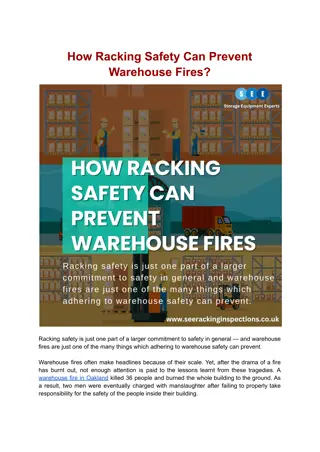Kitchen Safety Training for Preventing Burns and Fires
Learn about preventing burns and kitchen fires with this comprehensive training from the Bureau of Workers' Compensation in Pennsylvania. Discover the degrees of burns, first aid tips, deep fat fryer safety, burn prevention tips, and more. Stay safe in the kitchen by understanding how to handle burns and fires effectively.
Download Presentation

Please find below an Image/Link to download the presentation.
The content on the website is provided AS IS for your information and personal use only. It may not be sold, licensed, or shared on other websites without obtaining consent from the author.If you encounter any issues during the download, it is possible that the publisher has removed the file from their server.
You are allowed to download the files provided on this website for personal or commercial use, subject to the condition that they are used lawfully. All files are the property of their respective owners.
The content on the website is provided AS IS for your information and personal use only. It may not be sold, licensed, or shared on other websites without obtaining consent from the author.
E N D
Presentation Transcript
KITCHEN SAFETY Bureau of Workers Compensation PA Training for Health & Safety (PATHS) Preventing Burns & Kitchen Fires PPT-020-01 1
Topics Degrees of Burns First Aid for Burns/Scalds Deep Fat Fryer Safety Burn Prevention Tips Kitchen Fires Fire Extinguishers PPT-020-01 2
Degrees of Burns o First Degree minor and heal quickly. Symptoms = reddened skin, tender, sore o Second Degree serious and require immediate first aid & professional medical treatment. Symptoms = blistered skin, very painful o Third Degree severe and require immediate professional medical treatment. Symptoms = white, brown, or charred tissue, often surrounded by blistered areas; little of no pain at first PPT-020-01 3
Degrees of Burns PPT-020-01 4
First Aid for Burns/Scalds o First & Second Degree = Cool the burned area with cool, running water for 10 minutes. o Third Degree = Get medical attention immediately! Cool only with wet, sterile dressings. o After the burned area has been cooled, cover with a clean, dry dressing. o Do NOT put butter or any other grease including medicated ointments on a burn! PPT-020-01 5
First Aid for Burns/Scalds o Do NOT break blisters! o If clothing has been burned, remove that part which isn t stuck to victim. o If possible, remove jewelry from around burned area before swelling begins. o Treat for shock by keeping the victim s body temperature normal; cover unburned areas with a dry blanket. PPT-020-01 6
Deep Fat Fryer Safety o Never put water or other liquid into hot cooking oil it turns to steam instantly and can violently explode hot oil in all directions. o Be careful when adding food to a deep fat fryer: if the fat is too hot or there are pockets of liquid in the prepared food the hot fat/oil will spray up. o Turn the Fryer off when leaving for the day. PPT-020-01 7
Burn Prevention Tips o Remember that steam will rise from a pot of boiling water when the lid is removed. o Use a pot holder and lift lids so that the end farthest away from you comes up first. o Leave a cloth or oven mitts on a hot lid lying on a counter top to alert others the lid is hot. o Turn pot handles in so that they can t be bumped or the pots knocked over. PPT-020-01 8
Burn Prevention Tips o Don t leave spoons or other utensils in pots while cooking. o Don t leave pots on stove unattended while cooking. o Turn off burners and ovens when they are not in use. o Keep plenty of dry pot holders and oven mitts near your cooking area. PPT-020-01 9
Burn Prevention Tips o When cooking wear clothing with tight fitting sleeves or roll your sleeves up. o When using a microwave, use only containers designed for safe use. o Before carefully removing covers on food cooked in a microwave, ensure the food has cooled down. o Keep things that burn such as dishtowels, paper, etc. at least 3 feet from the range top. PPT-020-01 10
Burn Prevention Tips o Keep grease from building up on range tops, hoods, and appliances. o Keep hot pans, beverages, and trays away from the edge of a counter. o Use pot holders or oven mitts when moving/carrying hot pans, trays, etc. o Use caution when moving about within the kitchen due to hot grills, range tops, ovens. PPT-020-01 11
Kitchen Fires o Most kitchen fires start due to the heating of fat or oil. o Unattended cooking can also result in a kitchen fire. o When oil/fat gets hot it smokes a little at first, but if it gets hotter it bursts into flame. PPT-020-01 12
Kitchen Fires o To extinguish a fat/oil fire cover it with a damp cloth, or use a fire extinguisher. o Make sure you turn off the gas or power. o NEVER USE WATER on a fat/oil/grease fire! o Do NOT attempt to carry or move a pan that s on fire. o Keep the appropriate lid close by while cooking so you can cover a pan that s on fire. PPT-020-01 13
Fire Extinguisher Use o Fire extinguishers are marked to indicate the class of fire they can be used on. o Access to fire extinguishers should not blocked/obstructed. o After a fire extinguisher is used it must be recharged, not put back in place. o Most fire extinguishers will make a mess! PPT-020-01 14
Fire Extinguisher Classifications PPT-020-01 15
Class of Fires Class A= Ordinary Combustibles (.e.g Wood, Paper, Rubber) Class B = Flamamble Liquids/Gases (e.g. Gasoline, Methane) Class C = Energized Electrical (e.g. electrical appliance plugged in) PPT-020-01 16
Class D Fires Class D Fires = Combustible metals (e.g. titanium, aluminum) Extinguishers for these classes of fire: o Often specific for type of metal in question o No picture designator o No rating; also not given multi-purpose rating PPT-020-01 17
Class K Fires o Class K fires occur in cooking grease made from animal fat. o These fires usually burn very hot and can be dangerous to extinguish. o There are special fire extinguishers that are used for these types of fires and are usually in kitchen areas of restaurants/cafeterias. PPT-020-01 18
Class K Fire Extinguisher Looks like a 2 gallon pressurized water extinguisher don t get them mixed up! Use the labels/markings on all extinguishers to ensure you have the correct one! PPT-020-01 19
To Use: P.A.S.S. o P = Pullthe pin on the fire extinguisher handle. o A = Aim the nozzle/horn of the extinguisher at the base/bottom of the fire. o S = Squeeze the fire extinguisher handles together to make the extinguisher work. o S = Sweep the extinguisher from side to side as if you were using a broom. PPT-020-01 20
Used Extinguisher o Never put a fire extinguisher that s been used back in place (even if it still feels heavy). o Even a short burst can cause the extinguisher to leak pressure after use. o Putting a used extinguisher back in place can mean it won t work in the future. o Have used extinguishers checked and recharged by a reputable dealer. PPT-020-01 21
Think Safety! o Burns can be VERY painful and kitchen fires can be devastating. o The bottom line in preventing burns and kitchen fires is to use common sense and safe practices. o Never take anything for granted when working in a kitchen treat pots, pans, and cooking surfaces as being hot unless YOU know for sure they are not. PPT-020-01 22
Contact Information Health & Safety Training Specialists 1171 South Cameron Street, Room 324 Harrisburg, PA 17104-2501 (717) 772-1635 RA-LI-BWC-PATHS@pa.gov Like us on Facebook! - https://www.facebook.com/BWCPATHS PPT-020-01 23
Questions????? PPT-020-01 24























